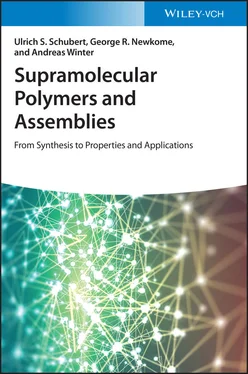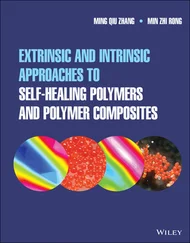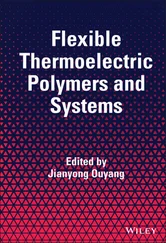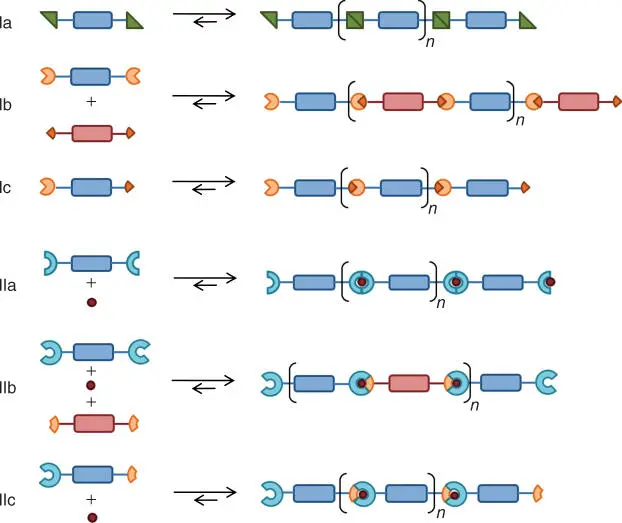
Figure 1.2 Schematic representation of the different types of supramolecular polymerization.
Source: Winter et al. [39]. © 2012 Elsevier B.V.
In general, the formation of polymers, via a polycondensation or polyaddition, represents a kinetically controlled process [26]: the potential barrier for the forward reaction (i.e. the polymerization) is much lower than for the backward reaction (i.e. depolymerization). As a consequence, neither changes in concentration (i.e. dilution) nor temperature (i.e. heating) will affect the molar mass or the degree of conversion. In supramolecular polymerizations, the situation is much more complicated – due to the (partially) reversible character, depolymerization must be considered. Thus, heating or dilution of a kinetically unstable supramolecular polymer will have a tremendous effect with respect to the molar mass – unlike for a common macromolecule, a decrease of M nwill be the result. According to Carothers' equation ( Eq. (1.1)), the molar mass of polymers, which have been prepared by either a polyaddition or a polycondensation, can be correlated to the monomer conversion. However, for supramolecular polymers, featuring a certain degree of reversibility of the non‐covalent interactions, the molar mass will mainly depend on the strength of these interactions, i.e. their association constants ( K avalues). As depicted in Figure 1.3, both high K avalues and high monomer concentrations are required to obtain the supramolecular polymers with high DPs. Besides these considerations, other parameters, such as concentration, temperature, and the particular reaction conditions (i.e. presence of additives or reagents, etc.), will also have an impact on the entire assembly process.
(1.1) 
where DP: degree of polymerization, p : monomer conversion.
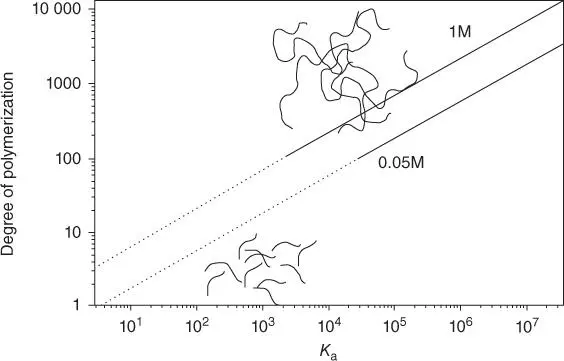
Figure 1.3 Representation of the theoretical DP as a function of the association constant ( K ain M −1) for a typical supramolecular polymerization according to an isodesmic model at two different concentrations.
Source: Brunsveld et al. [27]. © 2001 American Chemical Society.
This assumption, however, represents only a simplification of the actual mechanism of a supramolecular polymerization – even when only considering the thermodynamic equilibrium state, where assemblies are formed that, ideally, retain their polymeric structure over time. In this respect, three main mechanisms can be listed ( Figure 1.4) [26]:
1 The isodesmic supramolecular polymerization (IDP) is comparable to the step‐growth polymerization of esters (i.e. showing a broad dispersity, Đ) and the DP is strongly dependent on the Ka value of underlying supramolecular interaction.
2 The ring‐chain‐mediated supramolecular polymerization features an equilibrium between supramolecular cyclic species and linear polymer chains.
3 The cooperative supramolecular polymerization shows a nonlinear growth of the polymer chains and is typically nucleated.
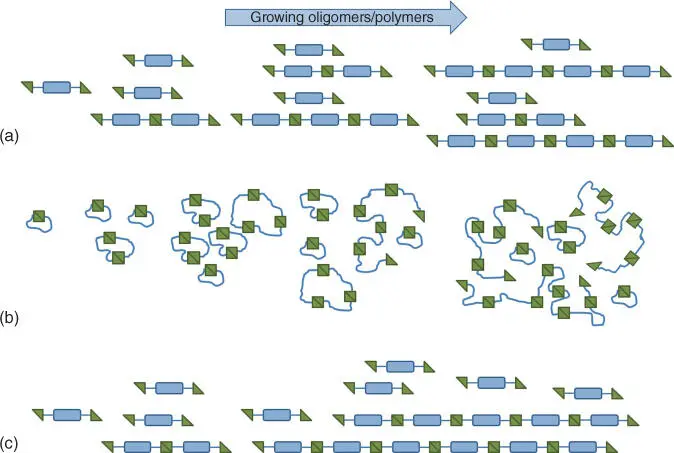
Figure 1.4 Schematic representation of the three main mechanisms known for the supramolecular polymerization processes: (a) isodesmic, (b) ring‐chain mediated, and (c) cooperative supramolecular polymerization.
Source: Winter et al. [39]. © 2012 Elsevier B.V.
Going beyond the “traditional” equilibrium state, supramolecular polymerizations leading to assemblies in either dissipative nonequilibrium or even non‐dissipative nonequilibrium states (i.e. kinetically trapped or metastable ones) have recently attracted substantial interest. In these cases, the progress of the polymerization is heavily dependent on the applied preparative method (the so‐called pathway selection), and an in‐depth knowledge of the kinetics is required. In particular, the association rates for each single step become more important. These issues have recently been discussed by Sorrenti et al. in a tutorial review [40].
1.3.1 Isodesmic Supramolecular Polymerization
The isodesmic supramolecular polymerization (IDP, isos: equal, desmos: bond), also often referred to as the “multi‐stage open association” mechanism [28, 41, 42], involves the formation of one type of reversible, non‐covalent interaction between monomers, oligomers, and eventually even polymer chains ( Figure 1.5). All supramolecular bonds, which are formed throughout the entire process, are considered to be identical, and thus, the reactivity of all species present is considered to have the same reactivity (i.e. monomers, oligomers, and polymers). Thereby, the neighboring group effects or additional interactions with non‐adjacent sites are neglected. Each single step of the process is characterized by the intermolecular equilibrium constant K ( Figure 1.5) – regardless of the chain length. As a result, from the equivalence of each individual polymerization step, IDPs do not exhibit any critical values for the concentration or temperature of the supramolecular polymerization (cpc: critical polymerization concentration, cpt: critical polymerization temperature) [41, 43]. Unlike for the ring‐chain‐mediated polymerization ( vide supra ), no cyclic species can be found during the self‐assembly process. The counterpart to IDP in “traditional” polymer science is the step‐by‐step reversible polycondensation where intramolecular cyclizations are absent and Flory's “principle of equal reactivity” is obeyed [44, 45]. Detailed investigations have shown that, for example, the polycondensation of decanedioyl chloride with 1,10‐decamethylene glycol in dioxane meets these requirements [46].
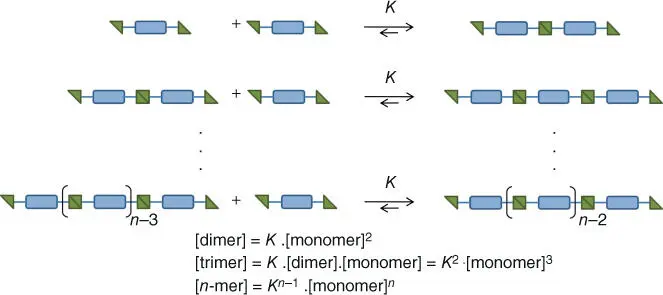
Figure 1.5 Schematic representation of the IDP in which the intermolecular equilibrium constant ( K) is independent of the length of the assembly (the mechanism is shown for a bifunctional monomer of the Ia‐type, see also Figure 1.2).
Source: Winter et al. [39]. © 2012 Elsevier B.V.
According to the rules of thermodynamics, the free energy of the system constantly decreases when the monomeric units are successively added to the growing polymer chain; this, in turn, further supports the assumption that binding of a monomer to the terminus of a polymer chain is independent of its length (an idealized energy diagram, in which kinetic barriers within the self‐assembly process are neglected, is depicted in Figure 1.6a) [26].
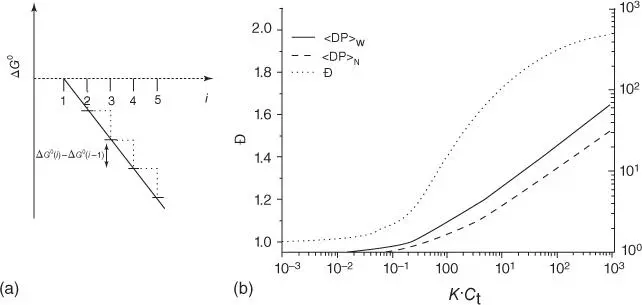
Figure 1.6 (a) Schematic drawing of an energy diagram for an IDP ( i : size of the oligomer, Δ G 0: free energy in arbitrary units). (b) Evolution of the number‐ and weight‐averaged DP ( Nand W) and the dispersity ( Đ ) as a function of equilibrium constant and total concentration of monomer ( K · c t).
Читать дальше
